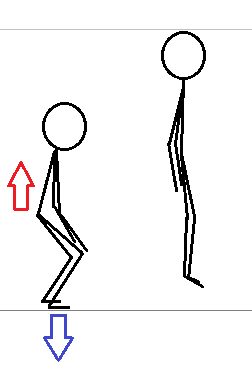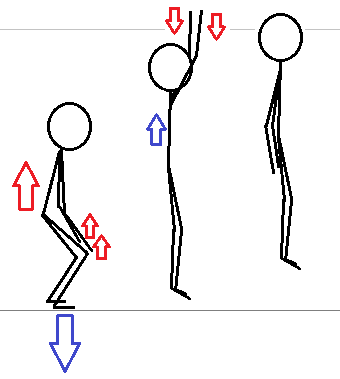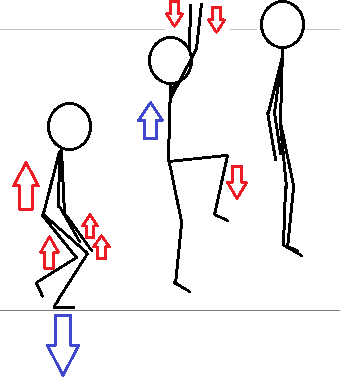Jumping may seem to be a fairly clear maneuver: after bending the legs in a slight squat, the leg muscles are rapidly contracted, causing an extension of the legs and an acceleration of the body upwards. Extension of the foot at the ankle provides some additional acceleration over a faster upper body velocity since there is less mass displaced downwards to maintain contact with the ground. So far this analysis ignores the presence of the upper body. To what extent is the upper body a contributor for a successful jump?
To achieve a high vertical jump, one must have a high velocity at takeoff, since from the moment of leaving the ground one can no longer exert propulsion and travels along a ballistic trajectory. To achieve a long distance jump, one must have a high velocity at takeoff, and the velocity must be directed in accordance with the destination of the jump (as derived earlier, the takeoff direction should be along the line that bisects the angle between a vertical line at the start of the jump and a line from the start to the end of the jump).
The leg muscles can exert a certain force to accelerate the body upwards at the beginning of the jump. The relation between the force of the muscles and the force transmitted to the ground depends on of the cantilever effect of the knee joint. When the leg is bent deep at the knee, movement requires a lot of muscle force but can reach high velocities, and when the leg is nearly straight, movement requires little muscle force but remains at low velocity. During a jump almost the opposite is needed, so one can readily become limited not by muscle strength but by muscle speed and the mechanics of leg extension. Performance may be improved by adjusting the force profile of the legs by also accelerating the arms. In particular, accelerating the arms upwards exerts a force down through the legs, and accelerating the arms downwards exerts an upwards force on the body. By starting a jump with the arms low to the ground, pushing off with the legs, and then rapidly accelerating the arms upwards when the legs are nearly straight, one increases the force on the legs during the time when they are more capable of handling a high force, and accelerates the mass of the arms when the legs are less capable of generating whole-body acceleration. The net result is that after leaving the ground the body center of mass is at a similar velocity but the arms are at an even faster velocity upwards. Near the apex of the jump, the arms may be accelerated downwards, almost like a bird flapping its wings, and this acceleration provides an extra impetus to the jump.


Cartoon illustration of a jump without the use of arms on left, and with the use of arms on right. If the arms are accelerated upwards during the takeoff, an extra force is exerted on the ground, and this is added to the jump by accelerating the arms downwards once in the air. Red arrows indicate acceleration direction and blue arrows indicate the counterforce due to acceleration.
How much of a difference does the use of arms in a jump really make to jump height, and can this be further improved by holding heavy objects to use as "momentum storage"? We face the question of how to measure the height of a jump consistently, which is more difficult than it sounds:
What I wanted to measure was the motion of the body's center of mass during a jump, and the center of mass is somewhere near the navel. I ended up wearing a crop top and recording my jump with a camera set up about 6 meters away to minimize impacts of lens distortion and movement towards or away from the camera. The jump spot was marked on the ground so it would be at the same distance from the camera every time. Then it is possible to go through the video frames and find the distance in pixels that I traveled upwards during a jump. This is converted to a value in meters based on a calibration at the same distance from the camera (recording myself holding an outstretched measuring tape).
I jumped vertically (both legs) with different use of arms: holding arms still, accelerating the arms as described above, and also holding various heavy objects while accelerating the arms. I switched the order of the various conditions in each trial and took breaks so that the result would not be affected by fatigue.
| Jump height | Condition |
|---|---|
| 45 cm | Arms held still |
| 48 cm | Arms accelerated up while holding spray cans (approx. 500 g each) |
| 52 cm | Arms accelerated up without holding anything |
| 56 cm | Arms accelerated up while holding dumbbells (approx. 5 kg each) |
The measurements suggest that jump height may be increased by over 5 cm (or 0.1 ratio) by using the arms, which is a significant improvement. There is maybe 1 cm or so that comes from the increased confidence in landing correctly when using the arms, allowing me to take a more energetic jump than in the case where I have to hold my arms still, but there is certainly a physical advantage to accelerating the arms. Interestingly, when holding a full can of spray paint in each hand, the jump height is lower than when not holding anything - it seems that the compressibility and sloshing of the contents inside the cans acts as a "mass damper" during the attempt to rapidly accelerate the arms, taking away energy from the jump and converting it into frictional heating inside the cans. With the 5 kg dumbbells, there is a clear advantage and a gain of a further 4 cm (0.077 ratio) on jump height over the case of not holding anything. For high end competitions where every cm counts, this effect is something to keep in mind.
This is not the end of the upward acceleration story, though. Likely you have an intuition that jumping from one leg is somehow easier than jumping from two legs. A part of this comes from the typical running start with a one-leg takeoff as opposed to a standing start with a two-leg takeoff, but even when moving with an existing forward velocity, the two-leg takeoff still feels more difficult. This is strange, because with two legs on the ground the jumper should have twice the accelerating force, so the two-leg takeoff should be easier.

Cartoon illustration of taking off for a jump with one leg on the ground and the other leg accelerated up along with both arms. An extra force is exerted on the ground, stored as inertia in the moving limbs, and jump height is increased.
What accounts for the difference? In the one-leg takeoff, the other leg is available for inertial storage: like the case of upwards accelerating arms, the free leg may be accelerated upwards during takeoff and accelerated downwards near the apex of the jump. Compared to the arms, the leg is heavier and more powerful, so its inertial boost to the jump is more substantial. Using this principle it is even possible to jump without bending the knees at all: if you stand with both legs straight, with the arms initially held down then rapidly accelerated upwards, the momentum from the arms decelerating at the top of the swing can lift you a few cm off the ground. If you stand on one leg, fully extended, and accelerate the arms and the free leg upwards, the resulting momentum can lift you even higher. Adding in forward velocity and an initial upward acceleration from the leg in contact with the ground, the cantilever effect of the knee is made to more effectively match the jump by the rotation at the hip and ankle joints when moving forward. Accelerating the free leg during the latter part of the takeoff when the leg on the ground is extended and capable of transmitting high forces through the bone achieves a better mechanical impedance match between force and acceleration.